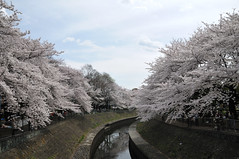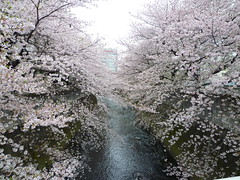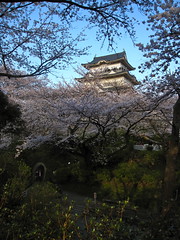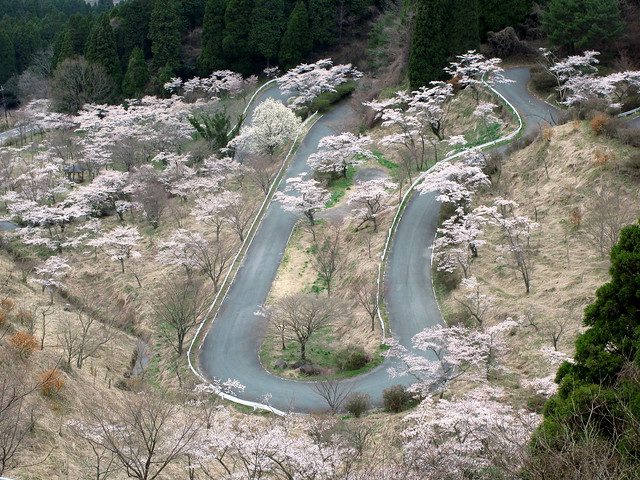 |
| Chidorigafuchi(千鳥ヶ淵) in Tokyo photo by euzim.net |
In Yokohama, most schools held entrance ceremonies on April 5th.
A low-pressure system as strong as a typhoon caused storm damage in many areas last week.
 |
| 目黒川の桜 チョイチョイ by -hae- /flickr Meguro River(目黒川) in Tokyo |
Yoshino Cherry is a cherry cultivar that gardeners and craftsman at Somei in Edo(now Tokyo) grew and offered in the first half of the 18th century. It's not seed-propagated cultivar and can be propagated by seeding or grafting.
 |
| 桜 sakura_17 by ajari /flickr Zenpukuji River(善福寺川) in Tokyo |
 |
| sakura-mochi(桜餅) |
 |
| 神田川・面影橋の桜 by kuracom /flickr Kanda River(神田川) in Tokyo |
The wild cherry trees crossbreed easily.
Yoshino Cherry has lifespan of about 60 years, but attempts have been made to extend their life.
We can check this year's bloom status of the cherry blossoms in major viewing spots all over Japan.
 |
| Ryoan-ji Temple photo by KYOTOdesign |
・Best time to see it: late March to mid April
・Varieties of cherry trees: Yoshino cherry, Beni-shidarezakura(紅枝垂桜, Cerasus spachiana ‘Pendula Rosea’), Yamazakura(山桜, Cerasus jamasakura (Koidzumi)H.Ohba) or Prunus serrulata), double-flowered cherry blossoms(八重桜, Yaezakura)
Nihon Sakura no Kai Foundation (literally, association for cherry blossoms in Japan) chose '100 best cherry blossoms viewing points in Japan' in March 1990.
 |
| 桜、池 by hiyang.on.flickr /flickr Inokashira Onshi Park |
Inokashira Onshi Park(井の頭恩賜公園) in Tokyo
(one of 100 best cherry blossoms viewing points )
The sites of castles or the ruins of ancient castles are covered with cherry blossoms.
 |
|
by lesterwalbrugh /flickr
|
Odawara Castle in Kanagawa Prefecture (one of 100 best cherry blossoms viewing points)
Its cherry trees are fully in bloom now.
 |
| Photo by Yokaphoto.net Kumamoto Castle |
Kumamoto Castle in Kumamoto Prefecture(one of 100 best cherry blossoms viewing points)
Petals of its cherry trees flutter down.
Long-lived, lone cherry trees also attract many visitors.
Yamataka Jindai-zakura(山高神代桜) in Yamanashi Prefecture, Neodani Usuzumi-zakura(根尾谷 淡墨桜) in Gifu Prefecture, Miharu Taki-Zakura(三春の滝桜) in Fukushima Prefecture are called three major lone cherry trees.
 |
| Yamataka Jindai-zakura photo by euzim.net |
・Location: Jisso-ji Temple(実相寺), Hokuto City, Yamanashi Prefecture
・Best time to see it: early April
・Age: about 2000
・Varieties of cherry trees: Edohigan(Cerasus spachiana)
 |
| Neodani Usuzumi-zakura photo by euzim.net |
・Location: Usuzumi Park, Motosu City, Gifu Prefecture
・Best time to see it: early to middle April
・Age: over 1500
・Varieties of cherry trees: Edohigan(Cerasus spachiana)
 |
| Miharu Taki-Zakura photo by euzim.net |
・Location: Miharu Town, Tamura District, Fukushima Prefecture
・Best time to see it: middle to late April
・Age: over 1000
・Varieties of cherry trees: Beni-shidarezakura(紅枝垂桜, Cerasus spachiana ‘Pendula Rosea’)
cherry trees on Takamori Pass(高森峠), Aso-gun, Kumamoto Prefecture
 |
|
by TANAKA Juuyoh (田中十洋) /flickr
Takamori Pass
|
No comments:
Post a Comment